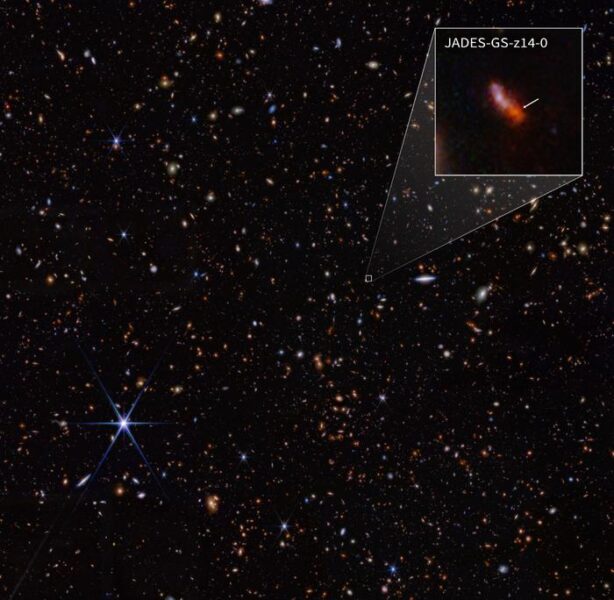Using NASA’s James Webb Space Telescope (JWST), an international team of astronomers has discovered a galaxy that challenges our understanding of the early universe. The galaxy, named JADES-GS-z14-0, existed a mere 290 million years after the Big Bang and boasts a mass equivalent to hundreds of millions of Suns, defying theoretical predictions.
The discovery came as part of the JWST Advanced Deep Extragalactic Survey (JADES) program, which aims to explore the Cosmic Dawn – the period when the first galaxies were born. Stefano Carniani from Scuola Normale Superiore in Pisa, Italy, and Kevin Hainline from the University of Arizona in Tucson, Arizona, shared their insights on this remarkable find.
A Surprising Find: Bright, Massive, and Dusty
Initially, the astronomers were cautious about their discovery due to the galaxy’s unexpected brightness and proximity to another galaxy. However, further observations with Webb’s Near-Infrared Spectrograph (NIRSpec) confirmed that JADES-GS-z14-0 was indeed at a redshift of 14.32, making it the most distant galaxy ever observed.
What makes this discovery even more astonishing is the galaxy’s intrinsic luminosity and size. Spanning over 1,600 light-years, JADES-GS-z14-0 is several hundreds of millions of times the mass of the Sun. This raises the question of how nature could create such a massive and luminous galaxy in less than 300 million years.
Unraveling the Mysteries of Early Galaxy Formation
The data from JADES-GS-z14-0 also reveal the presence of dust and ionized gas, indicating that multiple generations of very massive stars had already lived and died before the galaxy was observed. This challenges the current understanding of early galaxy formation and suggests that the universe may have been more diverse and complex than previously thought.
“All of these observations, together, tell us that JADES-GS-z14-0 is not like the types of galaxies that have been predicted by theoretical models and computer simulations to exist in the very early universe,” the researchers explained. “Given the relatively small region of the sky that we searched to find JADES-GS-z14-0, its discovery has profound implications for the predicted number of bright galaxies we see in the early universe.”
As astronomers continue to explore the Cosmic Dawn with the James Webb Space Telescope, it is likely that many more luminous galaxies will be discovered, potentially at even earlier times. These findings will undoubtedly reshape our understanding of the early universe and the processes that governed the formation of the first galaxies.
If our reporting has informed or inspired you, please consider making a donation. Every contribution, no matter the size, empowers us to continue delivering accurate, engaging, and trustworthy science and medical news. Independent journalism requires time, effort, and resources—your support ensures we can keep uncovering the stories that matter most to you.
Join us in making knowledge accessible and impactful. Thank you for standing with us!

